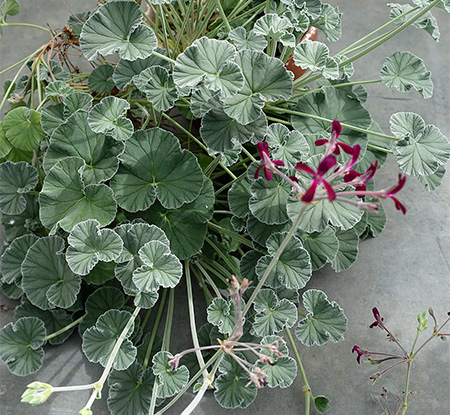Pelargonium sidoides
/If I could fill every available surface with pelargoniums, and particularly the species and scented varieties, I would do so: unfortunately I have a cat that thinks she’s a monkey (a Bengal, who leaps and climbs into anything and everything), and secondary glazing that has robbed the house of windowsills. However I wouldn’t be quite so unambiguous as that great raconteur Beverley Nichols, who says in his book Laughter on the Stairs:
Pelargoniums are for me a sort of test flower. For my experience has told me that people who do not like Pelargoniums have something morally unsound about them. Sooner or later you will find them out; you will discover that they drink or steal or speak sharply to their cat. Never trust a man or woman who is not passionately devoted to Pelargoniums.
But I do see what he means. And there is one beauty that I certainly wouldn’t want to be without: Pelargonium sidoides. This exquisite and elegant plant has small and crinkly, silvery, grey-green leaves with a feel like the finest silk-velvet and a curious, indescribable scent; and sprays of tiny, delicate flowers in an intense dark purple-red that last all summer, with the sprays getting longer and longer. They can be cut back at any time and more flowers will be produced.
Pelargonium sidoides, smith college
This plant has several common names, all alluding to its origin: South African Geranium, Cape Pelargonium, Rabassam and Kalwerbossi Geranium; it was introduced to the UK as early as the 1770’s and has been in popular cultivation since. It is surprisingly easy to grow and although tender will tolerate quite a degree of cold as long as its kept dry.
Whereas we may admire the beauty of Pelargonium sidoides, it has another role most of us are unaware of, which has ironically increased international demand and led to over-exploitation of the plant in the wild: The roots of this geranium have been used in its native South Africa for many centuries as an important medicine for upper respiratory tract infections (now with various brand names including Umckaloabo, which is close to the Zulu word for ‘severe cough’). The extract of the root (EPs7630) has come to the attention of many major pharmaceutical companies and national health institutes due to its reported anti-microbial, anti-viral and immune boosting actions, not just for bronchitis and asthma, but other conditions caused by microbial attack such as HIV.
Whilst research is ongoing, those who are lucky enough to enjoy this lovely plant for its own sake may ponder an interesting twist in another quote from the sublime Beverley Nichols who clearly was not aware of the hidden attributes of the Cape Pelargonium:
If these are the achievements of man, give me the achievements of geraniums.


